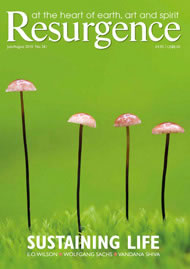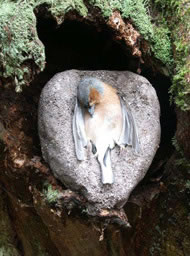Grief is not a rational thing. Neither is it just sadness. It is a cauldron of conflicting feelings that make little sense when experienced together but which carry our heart’s truth into the world when honoured separately. Grief is also an incredibly powerful force for change. I know this because as an environmental arts therapist I have watched countless people over the years use the conscious expression of grief to transform their lives, to move from places of despair, hopelessness and impotence into places of fruition, celebration and empowerment.
Grief is much underused. We identify it with the loss of a loved one, but in fact every time life changes, every time we are cast out of the garden of our own wellbeing, we are invited to grieve, and time and time again life will summon us into descent in order to do so. Grief is our way of letting go, and whatever we do not let go of we hold forever. Traditional communities knew this and made the open sharing of grief a living part of their ceremonial life, but that is rarely so in industrial societies. Instead, we have the distractions offered by our modern world, the stiff upper lip, positive thinking and antidepressants. But if we do not let go we cannot change. We get stuck.
There is a beautiful ritual that I use to help my clients enter consciously into grief. We seek a safe and holding womb-like space: somewhere dark and safe within the woods. Here, the ‘other’ is invited to find a place for fear, guilt, anger, sorrow and love. A place for all of these feelings can always be found in Nature, for she contains all that is wild and natural. The clients lay their hand on each ‘place’ in turn and speak everything that they feel there. They then speak in the first person to the one they are grieving, even if that is an aspect of self. They weep, they rage, they cough and spit and all that was clogged and stuck, a weight upon their heart and their lives, begins to flow. In the space that is left, in that deep well that they feared so much, there comes a great stillness. This is the space in which the seeds of all that they desire can now grow, seeds that had no room before. This is the great gift of grief: its re-birthing of the heart. From this place, change often comes at a pace that astonishes them.
Our fear and avoidance of emotional pain can have dire consequences. Cultural repression of grief can leave us with a great dark pool of unresolved feeling stretching all the way back into childhood. This can be too frightening to approach and so we push it down deeper into ourselves. Here it will gnaw at us for release, and often at transitional times of our life it will emerge as an unwelcome guest, demanding attention. It can make us ill, but there is worse.
Indigenous communities knew that the inner feminine, the feeling self, and the outer feminine, Nature, are one and the same. We rediscover this every day, working in therapeutic woodland. When we go into Nature with a sense of the interconnectedness of all things, the face of Nature herself becomes the shining surface of the dark pool in which we will always see ourselves reflected. Wherever we look, whatever we are drawn to, if we allow ourselves to open to the metaphor, we will always meet an aspect of ourselves. As we work outwardly with that aspect, our inner self is transformed.
But this also means that whatever we do to our inner world we do to the outer. If we abandon, neglect and abuse the inner feminine, the feeling self, we are likely to do so to the outer feminine, the natural world, as well. Is this why in the face of ecological destruction and climate change we find it so hard, collectively and individually, to act? Is this why as the wild beauty of the Earth is plundered we struggle to feel our grief at all that we are losing? Is it because we are simply doing to the world what we do to ourselves?
If so, we may not be able to truly feel or act on behalf of the outer until we have met and endured the inner. If so, the maxim ‘think globally, act locally’ has never been more true, but this time the immediate locality is the human heart.
Over the course of many years of working in therapeutic woodlands around Devon, England, it became apparent to me that the same metaphors were emerging spontaneously in people’s work at particular times of the year and that the Celtic Ogham tree calendar served as an Indigenous system of reference for this. Such a system evolved at a time when people lived so closely to Nature that there was no separation between the inner world of the individual and the natural world around. They were one and the same, and the rhythms and cycles of the year applied equally to both. This of course is still the case, but culturally we have become so removed from this relationship that many of us have long forgotten it.
In July, the Ogham leads us to the hazel, the tree of wisdom, poetry and deep knowing, and its metaphor is the dark pool. Hazel rods were used for divining the subtle undercurrents beneath the surface of the Earth. After the fires of the midsummer solstice, it is a time for stillness, a time to feel into what lies at the root of things. A theme that I often work with at this time is the place of greatest resistance, for this is usually where the healing is needed.
Certainly there is something very bipolar about our cultural tendency to swing between prophecies of doom that serve only to paralyse us further and unbridled consumerism that makes things worse. In my experience the place of greatest resistance is usually between such poles – where the grief is – so we swing from one to the other to avoid it. But we have much to grieve, not least the fact that we are the first generation in the history of humankind to lose our trust in the Earth, our trust that our great mother can sustain herself and us too. We are losing our home and ourselves in the process.
What a deep, dark pool of grief must lay hidden beneath that.
But if we allow ourselves to feel, share and release this grief, we can harness its power for change. It is an unrestrained masculine that has stripped the forests and based its unsustainable economy upon fossil fuels. The feminine, with its deep and inherent connection to Nature, would have led us in a very different direction had it not been so repressed. But the masculine is the active self, and if we would redeem ourselves for what we have done we need its power to act. Grief is so difficult because at its heart is love: the love of the one we are losing. In the throes of grief we reclaim that love, and in doing so we find again the anger to fight for it.
This beautiful, fragile Earth, our Holy love, calls us now into safe and secret spaces. Grief is a personal matter; concepts such as global warming and the loss of habitats and species may not move our hearts unless they affect us personally. But we can draw upon metaphors that connect us to matters that do touch us: the mortality of our bodies, the love of ageing parents, fears for our children. We reach for the tears and find them waiting. Taking our courage in our hands, we can then carve a path for change, for the planet, for ourselves.








